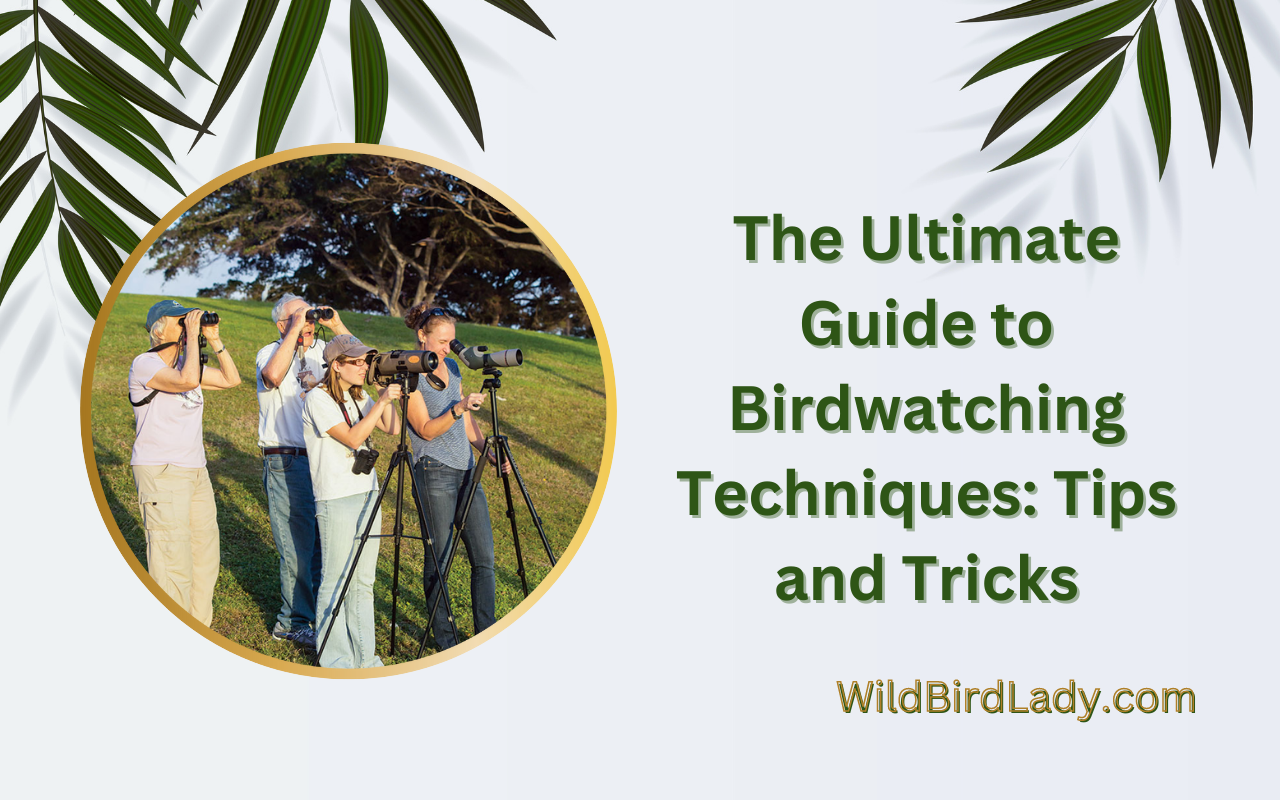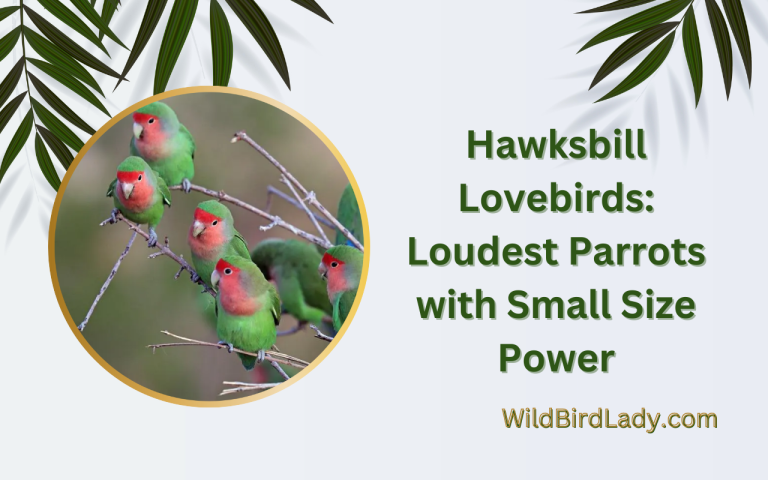The Ultimate Guide to Birdwatching Techniques: Tips and Tricks.
Some common birdwatching techniques include observation, identification, and recording of bird behavior through visual and auditory senses. Birdwatchers use binoculars, scopes, and cameras to observe birds in their natural habitat and to capture their behavior.
Additionally, birders may also use field guides, apps, and websites to identify bird species and learn more about their characteristics. Other techniques may include listening for bird calls, tracking migration patterns, and keeping records of sightings. Birdwatching is an activity enjoyed by millions of people around the world and has become an important part of eco-tourism, conservation efforts, and scientific research.
By using these techniques, birdwatchers can appreciate the beauty and diversity of bird species while contributing to their protection and preservation.
What Is Birdwatching?
Birdwatchers Vs. Birders
There is a common misconception that birdwatchers and birders refer to the same group of people, but in reality, there are some key differences between the two.
- A birdwatcher is someone who observes birds casually, either in their backyard or during a walk in the park. They may not have specialized equipment, and their interest in birds is more generalized.
- A birder, on the other hand, is someone who is more dedicated to the hobby. They typically have specialized gear such as binoculars, cameras and guidebooks, and may travel to specific locations known for their birding opportunities. Birders also keep a record of the birds they have seen, sometimes called a “life list.”
Why Birdwatching Is Popular?
Birdwatching has grown in popularity over the years, and for good reason. Here are some reasons why birdwatching is a beloved hobby for many:
- It’s a great way to connect with nature: Birding allows you to spend time outdoors, surrounded by beautiful scenery and fresh air. It can be incredibly relaxing and a great escape from the stress of daily life.
- It’s a fun challenge: Identifying birds can be a fun puzzle, as you try to match what you’re seeing with your guidebook or app. It’s a great way to sharpen your observational and critical thinking skills.
- It’s a great way to learn: Birding can be a fun and engaging way to learn more about ecology, biology, and environmental science. It’s also a great way to learn about different locations, as you research the best places to find certain species.
- It’s a great way to meet new people: Joining a birding club or group can be a great way to meet others who share your passion for birds. You can swap tips on the best equipment, share stories of exciting bird sightings, and even plan group trips to birding hotspots.
Overall, birdwatching is a fun and rewarding hobby that can provide endless opportunities for adventure and learning. So grab your binoculars and your guidebook, and head outside to see what feathered friends you can spot!
The Ultimate Guide To Birdwatching Techniques: Tips And Tricks
Birdwatching is one of the most peaceful outdoor activities you can enjoy. There’s nothing quite like the experience of watching these beautiful creatures in their natural habitat. Below we’ll discuss the ultimate guide to birdwatching, covering everything from understanding bird behaviors to the essential gear you’ll need and birdwatching etiquette to follow.
Understanding Bird Behaviors
Before venturing out to birdwatch, it’s important to understand a little bit about the animals themselves. Here are some key points to remember about bird behaviors:
- Birds are most active during the early morning hours, so try to go birdwatching an hour after sunrise.
- Birds often fly in patterns, so try to decipher the direction and speed of the flock to predict where they’re heading.
- Many birds are shy and wary of people. When approaching, it’s important to remain still and quiet.
- Some species of birds mate during certain times of the year, so understanding their mating behavior can significantly enhance your birdwatching experience.
Essential Gear For Birdwatching
Birdwatching requires a few essential pieces of gear. Before setting out on your adventure, make sure you have the following:
- Binoculars – the most essential tool for birdwatching. Look for binoculars with a magnification between 8x and 10x and an objective lens diameter between 25mm and 40mm.
- Field guide – a guidebook to help identify different species of birds.
- Camera – a great tool to capture your birdwatching experience. A telephoto lens can also capture high-quality images from a distance.
- Appropriate clothing – wear comfortable clothes that allow you to move freely and blend in with your surroundings. Use earthy colors to remain inconspicuous.
Birdwatching Etiquette And Safety
Observing birds and their natural habitats is a privilege. Remember, you’re a guest in their home. Here are some tips on birdwatching etiquette and safety:
- Do not disturb the birds. Give them plenty of space and remain quiet and still when observing them.
- Stay on designated paths when walking through protected areas. Flourishing bird habitats can be damaged easily.
- Do not feed the birds as this could interfere with their natural diets.
- Avoid shining bright lights and using flash photography because it could blind or disorientate the birds.
- Finally, adjust to your surroundings to avoid any unnecessary disturbance and always take your litter with you when leaving the area.
Top Birdwatching Techniques
When it comes to birdwatching techniques, preparation is key. With a little planning ahead, you can significantly improve your chances of spotting different species of birds. Here are some top birdwatching techniques:
- Scouting – try scouting the area in advance to get a feel for the terrain, and identify specific habitats. Look for spots that have trees, bushes, and water sources.
- Learning bird sounds – understanding bird calls and songs can help identify bird species from a significant distance. It’s always a good idea to familiarize yourself with bird sounds before embarking on your birdwatching trip.
- Patience – birdwatching often requires waiting in one place for extended periods. Make sure you have a comfortable seat or stand and take your time observing the wildlife.
- Reconnaissance – if you’re having difficulty identifying any bird species, conduct a reconnaissance to familiarize yourself with their characteristics.
- Joining birdwatching groups – participating in a birdwatching group can provide valuable knowledge and experience, as well as access to private lands.
Birdwatching is a gratifying and peaceful outdoor activity that requires patience, a basic knowledge of bird behaviors, and the right gear to maximize your chances of a memorable experience. Remember always to respect the birds and their habitats, and follow the birdwatching etiquette and safety guidelines.
Enjoy your birdwatching experience and, most importantly, have fun!
Choosing The Best Locations To Birdwatch
Birdwatching has become a popular pastime for many people around the world. It allows us to connect with nature and observe birds up close. However, choosing the right location is crucial to make the most of birdwatching. In this section, we will discuss the importance of location for birdwatching and how to find the best birding hotspots.
Importance Of Location For Birdwatching
Location is key to successful birdwatching. It can make the difference between seeing a lot of different bird species or none at all. Some things to consider when choosing a location for birdwatching include:
- Habitat: Different bird species are found in different types of habitats. For example, wetlands are an ideal location for watching waterbirds like ducks and herons, while woodlands are great for observing songbirds and woodpeckers.
- Season: Birds migrate during different seasons, so it’s important to choose a location that is suitable for the time of year. For example, the great lakes region is a popular birdwatching destination during the spring and fall migration.
- Weather: Birdwatching is best during dry and calm weather, as birds are more active and easier to spot.
- Access: Make sure the location is easily accessible and safe for birdwatching. Check for any entry restrictions and make sure you have the necessary permits.
Finding Birding Hotspots
Finding a good birding hotspot can greatly improve your birdwatching experience. Here are some ways to find the best birdwatching locations:
- Online resources: There are several websites and blogs dedicated to birdwatching that provide information about the best locations and recent bird sightings. Check these out before your trip to find the best birding spots in the area.
- Local bird watching groups: Joining a local bird watching group can give you access to valuable information about the best locations to watch birds in the area. You can also meet other birdwatchers and learn from their experiences.
- National parks and wildlife refuges: National parks and wildlife refuges are well-known birdwatching destinations. They often have designated birding trails and offer guided tours for birdwatchers.
- Ask a local: When in doubt, ask a local. They often have valuable information about the best birding spots in the area.
Choosing the right location is key to successful birdwatching. Consider factors like habitat, season, weather and access when choosing a location. Take advantage of online resources, local birdwatching groups, national parks and wildlife refuges and asking locals to find the best birding hotspots in the area.
With a little research and patience, you can have a great birdwatching experience.
Resources For Birdwatchers
Birdwatching is a fascinating activity that helps you connect with nature. It allows you to observe the beauty of birds and their unique behavior. There are different ways to enjoy birdwatching and resources available to enrich the experience. In this blog post, we will explore some common birdwatching techniques and resources for birdwatchers.
Websites, Books, And Apps For Birdwatching Enthusiasts
Technological advancements have made it easier to access a wealth of information related to birdwatching. Here are some resources that can enrich your birdwatching experience:
- Websites: Many websites focus on birdwatching and offer valuable resources such as bird identification, photography tips, and birding hotspots. Some popular websites include ebird, audubon, and cornell lab of ornithology.
- Books: Books are a valuable resource for birdwatchers, especially for learning about bird species and their unique behavior. There are many field guides available for different regions and species. Some popular books include ‘sibley guide to birds’, ‘national geographic field guide to birds of north america’, and ‘birds of europe’.
- Apps: There are numerous apps available for birdwatchers that offer features such as bird identification, bird call sounds, and birding hotspots. Some popular apps include merlin bird id, ibird pro guide, and ebird mobile.
Local Birdwatching Groups And Societies
Joining a local birdwatching group or society is an excellent way to connect with other birding enthusiasts. It also provides opportunities to learn more about birdwatching, share experiences, and explore new locations. Here are a few groups and societies to consider.
- Audubon society: With over 400 chapters and 1.9 million members, the audubon society is one of the largest birdwatching groups in the world. They offer events, educational programs, and volunteer opportunities to their members.
- American birding association: The american birding association is a nonprofit organization that promotes birdwatching and conservation. They offer resources, events, and publications to their members.
- Local birdwatching clubs: Many local birdwatching clubs offer events and opportunities to connect with other birding enthusiasts. These clubs are often run by volunteers and are a great way to explore birding hotspots in your area.
Birdwatching Festivals And Events
Birdwatching festivals and events are a fun way to learn about birdwatching and connect with other enthusiasts. Here are some popular festivals and events.
- Rio grande valley birding festival: This festival is held in texas and offers birding trips, workshops, and educational seminars.
- Cape may spring birding festival: This festival is held in new jersey and offers a variety of activities such as birding walks, boat tours, and workshops.
- Space coast birding and wildlife festival: This festival is held in florida and offers birding trips, workshops, and photography programs.
Birdwatching is an exciting way to connect with nature, and there are many resources available to enhance the experience. Whether it’s through websites, books, apps, or joining a local club, there are many ways to learn about birds and connect with other enthusiasts.
Birdwatching festivals and events are also a great way to explore new birding hotspots and connect with other birding enthusiasts.
Wrapping Up The Ultimate Guide To Birdwatching Techniques
Birdwatching is a fascinating and rewarding pastime. Whether you’re a beginner or an experienced birder, there are plenty of techniques and tips to enhance your birding experience. We have covered various birdwatching techniques that will help you make the most out of your time in nature.
Let’s wrap up the ultimate guide to birdwatching techniques with a quick recap of the key takeaways.
The Joy Of Birdwatching And Why It’S Worth Trying
Birdwatching is more than just collecting species. It is an immersive, rewarding, and educational experience that helps us stay connected with nature. Here’s why it’s worth trying:
- Birdwatching is a great way to enjoy nature, connect with wildlife, and reduce stress.
- It can help you develop new skills, such as bird identification, habitat recognition, and understanding bird behavior.
- Birdwatching provides a sense of accomplishment and can be a great way to bond with friends and family.
Recap Of Tips And Techniques Shared In The Article
We have covered several birdwatching techniques that can help you become a better birder:
- Time your birding session to coincide with the birds’ peak activity.
- Learn to identify birds by sight and sound.
- Use a bird field guide and binoculars to enhance your birdwatching experience.
- Stay quiet and still to avoid scaring away birds.
- Observe the birds’ behavior and habitat to learn more about them.
- Join a birdwatching club or community to learn from other birders.
- Practice ethical birdwatching and avoid disturbing the birds or their habitat.
By following these tips and techniques, you can transform your birdwatching experience from ordinary to outstanding. So, grab your binoculars, field guide, and birdwatching checklist and head outdoors to discover the beauty of the avian world.
Frequently Asked Questions For What Are Some Common Birdwatching Techniques?
What Is Birdwatching?
Birdwatching is the observation of wild birds in their natural habitat, either with or without binoculars or spotting scopes, with the intent of studying their behavior, identifying species, or simply enjoying their beauty.
What Equipment Do I Need For Birdwatching?
A good pair of binoculars, a field guide, and comfortable clothing and footwear are the essential equipment for birdwatching.
How Do I Identify Different Bird Species?
Look for distinct physical characteristics, such as beak shape and size, plumage color and pattern, and overall size and shape. A field guide and online resources can aid in identification.
What Are The Common Birdwatching Techniques?
Scanning the area with binoculars, keeping quiet and still to observe birds without frightening them, and listening for bird calls and songs are common birdwatching techniques.
Where Is The Best Place To Go Birdwatching?
Birdwatching can be done in parks, nature reserves, forests, wetlands, and other natural areas, depending on the species you wish to observe. Do some research to identify the best locations.
Can I Birdwatch Without Disrupting Their Habitat?
Yes, it’s important to respect the habitats of the birds you are observing. Keep a safe distance and avoid disturbing their natural behavior or nesting areas.
Conclusion
To sum up, birdwatching is an activity that requires patience, focus and practice. By using different techniques and strategies, observing birds in their natural habitats can bring immense joy and satisfaction. The most common techniques to identify and observe birds include the use of field guides, binoculars, listening to their calls, and observing their behavior.
Understanding bird habitats, migration patterns, and breeding seasons can also aid in spotting and identifying different species. Additionally, joining local birdwatching groups and participating in conservation efforts can enhance knowledge and appreciation of birds. Remember to be respectful of nature, keep a safe distance from birds and their nests, and abide by local regulations.
Birdwatching can provide a wonderful opportunity to connect with the natural world and appreciate the beauty of birds. Happy birdwatching!







